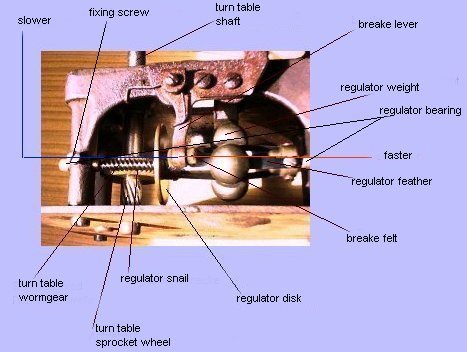
Bases of the gramophone technology
By any pictures the parts of the
gramophone are explained and some advices are given for the trouble shooting.
Most gramophones are constructed similarly and I hope to be able to help with
my limited state of experience other gramophone friends.
The regulator

The regulator for the speed is
from central importance:
The regulator snail is driven by the turntable wave,
The faster it turns, the more the take-up motion weights strive outwardly.
These pull the regulator disc against the brake felt about the take-up motion
feathers.
The farther this is removed from the regulator snail, the higher the possible
speed.
The regulator disc is a very frequent
cause for disturbances: Frequently deposits on her are to be found.
These care for tackers of the drive. If the disc is cleaned, results in one
substantially quieter run of the drive. With discs from injection moulding (gray
metal) can also be found that this corrodes strongly or even spoiled or have
torn. Here only remplacement helps. Also are to be drawn with all parts from
injection moulding screws only with a lot of feeling and caution! Attention
is to be given also to the brake felt: if this is hardened or is covered, results
also in the disturbing sounds. Cleaning or renewing and subsequent oils put
things right.
Particularly importantly is the setting of the bearings of the regulator shaft:
two eccentric bearings cares for a multiplicity of set possibilities.
The axial gap, also the possibility aside shifting of the wave, should be little,
it is too little raised friction and the shaft sticks or can be damaged. By
turning the bearing bush one puts the intervention of the snail into the worm
gear of the turntable. Also here a just still perceptible gap should be existing.
In addition one has the possibility, with worn or damaged worm gear of the turntable
to place the snail by twisting the sockets about 180 degrees higher or deeper.
So the snail can intervene in a not yet used area of the worm gear and run perfectly.
(If was with the illustrated regulator the case)
Importantly it is to draw the clamping screws the bearing bushs full of feeling
not to crush the bearing bush sen.
To the avoidance of eccentricities of the regulator should also be respected
to an even setting of the weights. With running engine one approaches carefully
and very slowly with a tallow pencil the circulating weights. Besides, the tallow
pencil in the housing should lie close to be able to be led safely. The mostly
deflect weight will touch first the pen and get a bit of paint. With this weight
the regulator feather is to be shortened. For this purpose almost each of these
feathers has a long hole at an end. The screw is solved and the feather is shifted
around a small amount outwardly. Tighten and the whole repeat, since the weights
circulate evenly.
A very weighty problem can represent the sticking of the regulator disc on the
regulator shaft. The engine also in fully wound up condition not or only difficultly
- can thereby turn the consequence: One winds farther up, in the hope him free-got
shut! It should be checked always whether the regulator disc can easily be shifted
along on the wave. (Experiences Itself!)
back
to records
english
start page